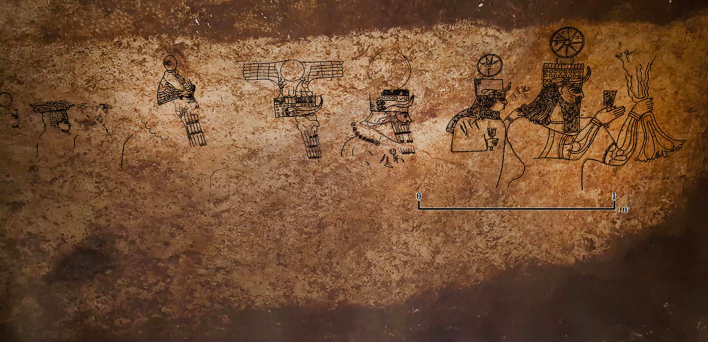Ancient Rock Art Depicting Divine Procession Discovered in Secret Chamber Beneath Turkish House
It may have been created as a way for Neo-Assyrian officials to curry favor with local residents
Elizabeth Djinis
Daily Correspondent
May 12, 2022 2:38 p.m.

This Assyrian rock art discovered under a home in southeastern Turkey was hidden by local looters.
Mehmet Önal; interpretative drawings by Önal, based on laser scan by Cevher Mimarlık
While constructing a home in Turkey, looters realized they’d been building atop an ancient chamber. Instead of alerting local authorities, they began to dig themselves—and only after the heritage criminals were apprehended did archaeologists arrive to save the day (and the artifacts within).
Now, a stone panel uncovered during their emergency excavation sheds new light on the melting pot of cultures that coexisted during the early days of the expansion of Mesopotamia’s Neo-Assyrian Empire nearly 3,000 years ago.
Scholars believe the work was left unfinished, since only the gods’ upper bodies or heads in profile are shown.

The panel shows “ … a local cohabitation and symbiosis of the Assyrians and Arameans in a region and period under firm Assyrian imperial control,” the authors write. They call the panel “ … a striking example of regional values in the exercise of imperial power”—a relationship that could have involved a give and take between Assyrians who wanted to impress their new subjects and Arameans eager to please their new overlords.
The site was likely uncovered when the home in the southeastern Turkish village Başbük was being built, reports National Geographic’s Tom Metcalfe. Instead of notifying authorities, looters cut a hole into the ground floor of the two-story home. On the other end of that makeshift entryway lay an ancient chamber hewn out of the limestone bedrock that led by staircase to another lower room.
More:
https://www.smithsonianmag.com/smart-news/rock-art-of-divine-procession-found-in-secret-chamber-beneath-turkish-home-180980072/

